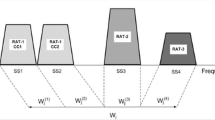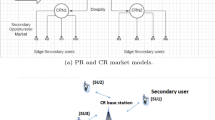Abstract
Deployment of multiple radio access technologies (RATs) at the same cell site enables the system to flexibly support different types of devices and services. Such multi-RAT systems call for an efficient utilization of the system resources as well as simplified management. In this paper, we take a user-centric approach and let each individual user equipment decide its own access strategy in a multi-RAT system with regulated interference constraints. The formulated problem is a generalized Nash equilibrium (GNE) problem. We show that there always exists a GNE but its uniqueness is not guaranteed. A closed form solution is provided to characterize a special class of the GNEs. We then propose a primal-dual algorithm with detailed convergence analysis for computing a GNE. The proposed algorithm may have practical implications in the design of multi-RAT systems.
摘要
创新点
在同一小区站点部署多种无线电接入技术能够灵活地支持不同类型的设备和服务, 但在这种多无线接入系统需要解决系统资源的有效使用和简化管理问题。 本文从用户的角度出发, 让每个用户设备决定自己在带有干扰约束的多无线接入系统的访问策略, 将该研究问题建模并抽象成一个广义的纳什均衡问题。 本文证明了广义纳什均衡点的存在性和非唯一性, 并对一类特殊的广义纳什均衡点给出了闭式解, 在此基础上进一步提出一个原始对偶优化算法并对其收敛性做了详细分析。 本文的分析研究和提出的算法对下一代移动网络多无线接入系统的设计具有极大启发意义。
Similar content being viewed by others
References
Ericsson. 5G Radio Access: Research and Vision. White Paper. http://www.ericsson.com/res/docs/whitepapers/wp-5g.pdf. 2013
Andrews J G, Buzzi S, Choi W, et al. What will 5G be? IEEE J Sel Areas Commun, 2014, (32): 1065–1082
Wireless World Research Forum Working Group C. Multi-RAT network architecture. White Paper. http://www.wwrf. ch/files/wwrf/content/files/publications/outlook/Outlook9.pdf. dy2013
Hasib A, Fapojuwo A. Analysis of common radio resource management scheme for end-to-end QoS support in multiservice heterogeneous wireless networks. IEEE Trans Veh Tech, 2008, (57): 2426–2439
Ong E H, Khan J Y. On optimal network selection in a dynamic multi-RAT environment. IEEE Commun Lett, 2010, (14): 217–219
Mu˜noz P, Laselva D, Barco R, et al. Dynamic traffic steering based on fuzzy Q-learning approach in a multi-RAT multi-layer wireless network. Comput Netw, 2014, (71): 100–116
Pollakis E, Cavalcante R L G, Stanczak S. Enhancing energy efficient network operation in multi-RAT cellular environments through sparse optimization. In: Proceedings of IEEE Workshop on Signal Processing Advances in Wireless Communications, Darmstadt, 2013. 260–264
Chiasserini C F, Gribaudo M, Manini D. Traffic offloading/onloading in multi-RAT cellular networks. In: Proceedings of IEEE IFIP Wireless Days, Valencia, 2013. 1–7
Choi Y, Kim H, Han S W, et al. Joint resource allocation for parallel multi-radio access in heterogeneous wireless networks. IEEE Trans Wirel Commun, 2010, (9): 3324–3329
Lim G, Xiong C, Cimini L, et al. Energy-efficient resource allocation for OFDMA-based multi-RAT networks. IEEE Trans Wirel Commun, 2014, (13): 2696–2705
Alsohaily A, Sousa E S. Unified radio access network operation for multi-radio access technology cellular systems. In: Proceedings of IEEE International Conference on Telecommunications, Lisbon, 2014. 32–36
Ma X, Sheng M, Zhang Y. Flow splitting for multi-RAT heterogeneous networks. In: Proceedings of IEEE Vehicular Technology Conference, Quebec City, 2012. 1–5
Yeh S P, Panah A Y, Himayat N, et al. QoS aware scheduling and cross-radio coordination in multi-radio heterogeneous networks. In: Proceedings of IEEE Vehicular Technology Conference, Las Vegas, 2013. 1–6
Facchinei F, Kanzow C. Generalized Nash equilibrium problems. 4OR-Q J Oper Res, 2007, (5): 173–210
Chen M, Ponec M, Sengupta S, et al. Utility maximization in peer-to-peer systems. SIGMETRICS Perform Eval Rev, 2008, (36): 169–180
Lin X, Lok T M. Distributed power control for one-to-many transmissions in Gaussian interference channels. IEEE Trans Commun, 2012, (60): 2363–2375
Monderer D, Shapley L S. Potential games. Games Econ Behav, 1996, (14): 124–143
Boyd S, Lieven V. Convex Optimization. New York: Cambridge University Press, 2004. 241–249
Khalil H, Grizzle J. Nonlinear Systems. New Jersey: Prentice Hall, 2002. 237–242
Lin X, Andrews J G, Ghosh A, et al. An overview of 3GPP device-to-device proximity services. IEEE Commun Mag, 2014, (52): 40–48
Author information
Authors and Affiliations
Corresponding author
Rights and permissions
About this article
Cite this article
Wei, N., Zhang, Z. Competitive access in multi-RAT systems with regulated interference constraints. Sci. China Inf. Sci. 60, 022306 (2017). https://doi.org/10.1007/s11432-015-0625-3
Received:
Accepted:
Published:
DOI: https://doi.org/10.1007/s11432-015-0625-3




